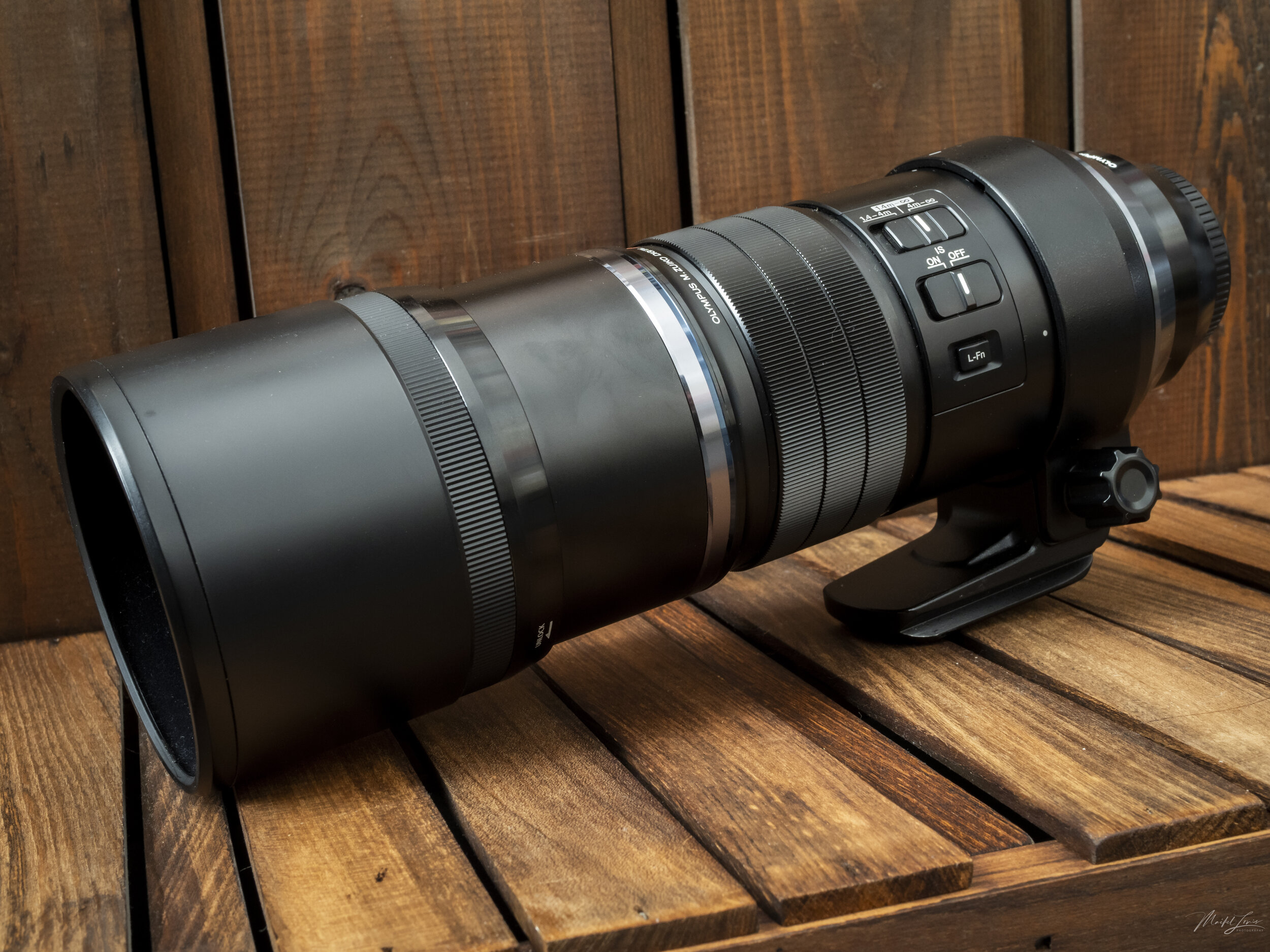Review OM-system / Olympus M. Zuiko Digital ED 300mm f/4.0 IS PRO.
This review is based entirely on real-life use. I’ve spent the last few months extensively testing this lens in a wide variety of conditions. All statements reflect my personal opinion and shooting style—no lab tests, just genuine field experience. I purchased this lens with my own money, and I have no sponsorships or affiliations. The review is divided into key sections, followed by my final verdict.
Build Quality – ★★★★★ (5/5)
Right out of the box, the Olympus 300mm f/4 PRO feels like a premium piece of equipment. The build quality is exceptional, crafted to high professional standards. It has a reassuring weight to it—solid without being too heavy—and everything about it feels refined.
The focus ring turns smoothly, and the built-in retractable lens hood operates quickly and locks firmly into place. The interior of the hood is lined with felt to reduce the chance of lens flare. The lens buttons give a satisfying tactile click, and overall, it feels like a lens made for professional use in the field. Without a doubt, this is a 5/5 for build quality.



Handling – ★★★★☆ (4/5)
A lens like this comes with a learning curve—especially when used on a Micro Four Thirds (MFT) body where it offers a 600mm equivalent field of view. Any small movement is amplified, so dialing in your settings correctly is crucial. Fortunately, when paired with Olympus bodies like the OM-1, E-M1X, or E-M1 Mark II/III, the in-body image stabilization (IBIS) works extremely well. It also functions on the E-M5 Mark III, though I found the ergonomics less ideal. A slightly heavier body helps balance the setup better.
The lens is compatible with Panasonic MFT bodies too, but lacks Sync IS (combined stabilization from both lens and body), which Olympus offers. Hopefully, more collaboration will bridge these gaps in the future. In the meantime, this lens performs best on Olympus bodies.
The built-in tripod foot is Arca-Swiss compatible—very convenient—but I wish it were slightly longer for more secure carrying. The tripod collar is removable, which is great for reducing weight and cleaning. However, the tightening knob is a bit awkwardly placed near the barrel, making adjustments tricky.
Control-wise, the lens features a customizable function button (I use it for AF mode selection), a stabilization switch, and a focus limiter with three ranges: 1.4–4m, 1.4m–infinity, and 4m–infinity. These controls significantly speed up autofocus performance. However, the focus limiter switch is recessed, making it difficult to find by touch when looking through the viewfinder.
Manual focus is activated by pulling back the focus ring, which is wide and smooth. This is especially helpful in challenging conditions like focusing on small animals partially hidden in foliage. The only downside: the ring can get bumped into MF mode when carrying the camera, so it's good practice to check it or disable this function via the menu.
The retractable lens hood is brilliant—not only for flare protection but also for convenience and safety. However, fine sand can occasionally get trapped between the hood and barrel, and because it’s not removable, deep cleaning can be a challenge. Still, the tight tolerances help prevent most dirt from entering.
One small note: the lens cap is easily knocked off if you're not careful when packing the lens. A simple fix is to rotate the cap 90 degrees or leave the hood extended. Personally, I’d prefer a center-pinch design like the one on the Olympus 12–40mm f/2.8 PRO.
Overall, the lens is compact, well-balanced (especially with an OM1 body), and easy to carry for a full day of shooting.
Olympus M. Zuiko Digital ED 300mm f/4.0 IS PRO
Optical Performance – ★★★★★ (5/5)
This is where the lens truly shines. The image quality is absolutely stunning—razor-sharp photos, rich colors, and beautiful contrast. Olympus nailed the optical formula with this lens.
The f/4 aperture produces pleasing, creamy bokeh, and thanks to the high level of sharpness, cropping is not an issue. You have a lot of freedom to reframe your shots without sacrificing detail. Even wide open, the corners remain sharp—something that’s not always the case with long telephoto lenses.
Again, this isn’t based on scientific lab testing—just thousands of real-world shots and comparisons with other telephoto lenses. From personal experience, this lens stands at the top of its class.
OM-1 MKII with the Olympus 300mm f4 pro
Autofocus Speed – ★★★★★ (5/5)
Autofocus speed is lightning-fast. There’s simply nothing more to wish for. Paired with a capable camera body, this lens becomes a dream setup for wildlife and sports photography.
For best results, I recommend high-end Olympus bodies like the OM-1, E-M1X, E-M1 Mark II/III, E-M5 Mark III, and OM-5. These offer both contrast and phase-detection autofocus, unlike many Panasonic bodies which rely more heavily on contrast detection (with the exception of the newer Panasonic G9 II, which now features a hybrid AF system).
With the right body, tracking fast-moving subjects—like birds in flight—becomes impressively easy. If you miss a shot, it won’t be because of your gear.
Conclusion
The Olympus M.Zuiko Digital ED 300mm f/4.0 IS PRO is a truly exceptional lens. It delivers professional-level image quality, fast and reliable autofocus, and robust build quality in a relatively compact package. Yes, there’s a learning curve, and yes, it has a few quirks when it comes to handling—but once you get used to it, it’s hard to put this lens down.
It also pairs beautifully with the Olympus MC-14 teleconverter for even more reach, though that’s a story for another review.
If you’re looking for a professional telephoto prime lens, this is the most affordable way to get a 600mm equivalent field of view with f/4 light-gathering power. It’s a masterpiece of engineering from Olympus / OM System.
Final Rating: ★★★★½ (4.5 out of 5 stars)
A truly professional and inspiring piece of gear.
Olympus 300mm f4 pro
OM-1 MKII with the Olympus 300mm f4 pro


